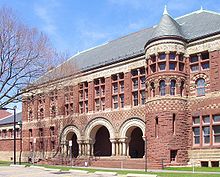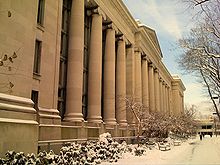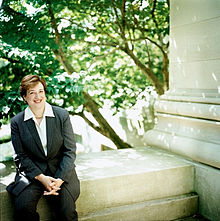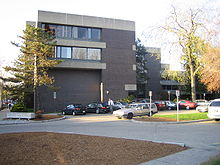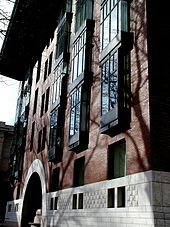- Harvard Law School
-
Harvard Law School 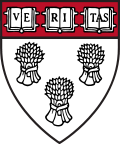
Established 1636 School type Private Endowment US$1.7 billion Parent endowment $26 billion Dean Martha Minow Location Cambridge, Massachusetts, USA Enrollment 1,800
1680 JD
150 LLM
50 S.J.D.Faculty 194[1] USNWR ranking 2[1] Bar pass rate 94.65%[1] Annual tuition $45,840[1] Website law.harvard.edu ABA profile Harvard Law School Profile Harvard Law School (also known as Harvard Law or HLS) is one of the professional graduate schools of Harvard University. Located in Cambridge, Massachusetts, it is the oldest continually-operating law school in the United States and is home to the largest academic law library in the world.[2][3] The school is routinely ranked by the U.S. News & World Report as the second best law school in the United States, behind Yale Law School.[4]
The current Dean of Harvard Law School is Martha Minow, who assumed the role on July 1, 2009. Harvard Law has 246 faculty members.[5] Many are preeminent legal scholars; Harvard Law School faculty were responsible for more downloaded papers on the Social Science Research Network than any other law school, a fact only partially explained by the school's size.[6]
Harvard Law School has produced a large number of luminaries in law and politics, including the current President of the United States, Barack Obama, and former President Rutherford B. Hayes. World leaders counted among its graduates include the current President of the Republic of China, Ma Ying-jeou; the current President of the World Bank Group, Robert Zoellick; the current United Nations High Commissioner for Human Rights, Navanethem Pillay; and the former President of Ireland, Mary Robinson. Some 149 sitting United States federal judges are Harvard Law School graduates; six of the nine sitting justices of the Supreme Court of the United States attended the law school (Chief Justice John G. Roberts and Associate Justices Anthony Kennedy, Stephen Breyer, Ruth Bader Ginsburg, Antonin Scalia and Elena Kagan). Seven sitting U.S. Senators graduated from the school.
Harvard Law School has also educated a significant number of leaders and innovators in the business world. Business leaders counted among its graduates include the current Chairman and CEO of Goldman Sachs, Lloyd Blankfein, current Chairman of the Board and majority owner of National Amusements, billionaire Sumner Redstone, current President and CEO of TIAA-CREF, Roger W. Ferguson, Jr., current CEO and Chairman of Toys "R" Us, Gerald L. Storch, and former CEO of Delta Air Lines, Gerald Grinstein, among many others.
Each class in the three-year J.D. program has approximately 550 students. The first-year (1L) class is broken into seven sections of approximately 80 students who take most first-year classes together. Harvard Law School graduates have accounted for 568 judicial clerkships in the past three years,[when?] including one-quarter of all Supreme Court clerkships. More than 120 from the last five graduating classes have obtained tenure-track law teaching positions.
Contents
Campus
Harvard Law School's campus is located just north of Harvard Yard, the historic center of Harvard University, and contains several architecturally significant buildings.
From 1849 to 1855, the Harvard Branch Railroad terminated within what would become the present Law School campus, close to its southwest edge. Austin Hall, the law school's oldest dedicated structure, designed by architect H. H. Richardson, was completed in that vicinity in 1884. The law school's student center, Harkness Commons, was designed by the Bauhaus's founder, Walter Gropius, and his firm, along with several law school dormitories. Together they make up the Harvard Graduate Center complex. Langdell Hall, the largest building on the law school campus, contains the Harvard Law Library, the most extensive academic law library in the world.
As of 2010, a new complex is rising on the northwest corner of the law school campus, designed by traditionalist architect Robert A. M. Stern.[7] The complex is set to marry the architectural themes present in Austin and Langdell Halls, as well as the Gropius buildings.
History
Harvard Law School was established in 1817, making it the oldest continuously-operating law school in the nation. (William & Mary Law School opened first in 1779, but closed due to the American Civil War, reopening in 1920.[8] The University of Maryland School of Law was chartered in 1816, but did not begin classes until 1824, and also closed during the Civil War)[9]
The Royall estate
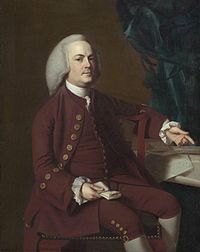 Portrait of Isaac Royall, painted in 1769 by John Singleton Copley
Portrait of Isaac Royall, painted in 1769 by John Singleton Copley
Its origins can be traced to the estate of Isaac Royall, who sold most of his Antiguan slaves and plantations to move to Medford, Massachusetts. His Medford estate, the Isaac Royall House, is now a museum, and includes the only remaining slave quarters in the northeast United States. The estate was passed down to Royall's son, Isaac Royall, Jr., who fled Massachusetts as the American Revolution broke out. Just prior to his death in 1781, Royall, Jr. left land to Harvard, the sale of which was intended for the "endowing of a Professor of Laws at said college, or a Professor of Physics and Anatomy". Harvard took the opportunity to fund its first chair of law. The Royall chair remains today. It traditionally was held by the Dean of the law school. The school's previous Dean, Elena Kagan, declined the Royall chair, instead giving herself the Charles Hamilton Houston Professorship.
In 1806, the Royall estate in Medford was returned to Royall, Jr.'s heirs, who sold it and donated the proceeds for the formal foundation of Harvard Law School. The Royall family coat-of-arms was adopted as the school crest, which shows three stacked wheat sheaves beneath the university motto (Veritas, Latin "truth").[10]
Growth and the Langdell curriculum
By 1827, the school, which was down to one faculty member, was struggling. An alumnus stepped in by endowing the Dane Professorship of Law and insisting that it be given to then Supreme Court Justice Joseph Story. Story's belief in the need for an elite law school based on merit and dedicated to public service helped build the school's reputation at the time, although the contours of these beliefs have not been consistent throughout its history. Enrollment remained low through the 19th century as university legal education was considered to be of little added benefit to apprenticeships in legal practice.
In the 1870s, under Dean Christopher Columbus Langdell, HLS introduced what has become the standard first-year curriculum for American law schools—including classes in contracts, property, torts, criminal law, and civil procedure. At Harvard, Langdell also developed the case method of teaching law, now the dominant pedagogical model at U.S. law schools. Langdell's notion that law could be studied as a "science" gave university legal education a reason for being distinct from vocational preparation.
While the law school had previously been located on Harvard Yard, the new system demanded lecture halls suited to the case law and interrogatory Socratic method of teaching. Henry Hobson Richardson would later design the law school's first independent home, the Romanesque Austin Hall, to the north of the Yard, with these needs in mind. This would come to form the nucleus of the current law school campus.
 Christopher Columbus Langdell
Christopher Columbus Langdell
As the 20th century dawned, Dean Langdell's innovations became standard in law school curricula across the country. The school also became the first to elevate legal education to a graduate-only discipline. Yet new theories, such as legal realism, blossomed at Yale and Columbia, while Harvard faculty members were generally known for their conservative approach.
20th century: Institutional criticism
As it rose to preeminence among law schools in the United States, Harvard attracted significant criticism for many perceived shortcomings.
Harvard Law was often believed to be a competitive environment. For example, Dean Berring of University of California, Berkeley School of Law once stated that he "view[ed] Harvard Law School as a samurai ring where you can test your swordsmanship against the swordsmanship of the strongest intellectual warriors from around the nation."[11] This was possibly historically true. When Langdell developed the original law school curriculum, Harvard University President Charles Eliot told him to make it "hard and long."[12][13] The school maintained a relatively uncompetitive admissions process, but "weeded out" a large number of first year students. This gave rise to the infamous legend of a dean at the school telling incoming students, "Look to your left, look to your right, because one of you won't be here by the end of the year."[14] Scott Turow's memoir One L and John Jay Osborn's novel The Paper Chase describe such an environment.
Whether the school ever was competitive is a subject of debate. A New York Times article from 1894 described in-class moot courts at Harvard as "co-operative."[15]
In addition, Eleanor Kerlow's book Poisoned Ivy: How Egos, Ideology, and Power Politics Almost Ruined Harvard Law School criticized the school for a 1980s political dispute between newer and older faculty members over accusations of insensitivity to minority and feminist issues. Divisiveness over such issues as political correctness lent the school the title "Beirut on the Charles."[16]
In Broken Contract: A Memoir of Harvard Law School, Richard Kahlenberg criticized the school for driving students away from public interest and toward work in high-paying law firms. Kahlenberg's criticisms are supported by Granfield and Koenig's study, which found that "students [are directed] toward service in the most prestigious law firms, both because they learn that such positions are their destiny and because the recruitment network that results from collective eminence makes these jobs extremely easy to obtain."[17]
The school has also been criticized for extremely large first year class sizes (at one point there were 140 students/classroom; as of 2001 there are 80), a cold and aloof administration,[18] and an inaccessible faculty. The latter stereotype is a central plot element of The Paper Chase and appears in Legally Blonde. Inaccessibility of the faculty was possibly a side effect of Harvard's original admissions process, which may have annoyed faculty by giving them less than stellar students.[13]
This Harvard Law persisted into the latter half of the 20th century,[12] but bears no resemblance to the modern school. The school eventually implemented the once-criticized[13] but now dominant approach pioneered by Dean Robert Hutchins at Yale Law School: It shifted the competitiveness to the admissions process. Robert Granfield and Thomas Koenig's 1992 study of Harvard Law students that appeared in The Sociological Quarterly found that students "learn to cooperate with rather than compete against classmates," and that contrary to "less eminent" law schools, students "learn that professional success is available for all who attend, and that therefore, only neurotic 'gunners' try to outdo peers."[17] According to the ABA, in 2007–2008 the school admitted only 11.8% of applicants and no students left as a result of "academic" shortcomings.[19]
Dean Robert C. Clark is generally given credit for "break[ing] the logjam" of the school's tenure battles and other political disputes.[20] Above all, many of the school's shortcomings were addressed head-on by the administration of Dean Elena Kagan after 2003.
The Kagan deanship
Elena Kagan sought to reverse many of the persistent stereotypes about the school when she assumed its deanship in 2003, promising reforms. She gave students her personal e-mail address, held office hours, successfully cut first year class sizes in half, and was given credit for a host of quality-of-life improvements at the law school, including an ice-skating rink (during the winter) and a beach volleyball court (the rest of the year) on campus, free coffee in classroom buildings, free tampons in campus public restrooms, and the renovation of several of the school's facilities.[21] She also managed to boost the school's involvement in international[22] and public interest law,[23] and hired a significant number of prominent new faculty members.[24]
The number of students interested in public interest law positions expanded as Harvard has begun to offer summer funding for public interest internships and low income loan reduction plans for alumni who take on careers in the public interest and academia. For example, the school introduced a program beginning with the J.D. Class of 2011, allowing students who pledged to spend five years working for nonprofit organizations or the government after graduation will receive a grant in the full amount of their tuition during their third year, and are entitled to keep the grant if they remain in such positions for the five-year period[25] (while the program remained in place for students who had relied on it, it was discontinued and replaced with other incentives in 2009).
The second half of the 2000s saw Harvard Law School's most dramatic academic changes since the implementation of the Langdell curriculum. In 2006, the faculty voted unanimously to approve a new first-year curriculum, placing greater emphasis on problem-solving, administrative law, and international law. The new curriculum was implemented in stages over the next several years,[26][27] with the last new course, a first year practice-oriented problem solving workshop, being instituted in January 2010. In late 2008, the faculty decided that the school should move to an Honors/Pass/Low Pass (H/P/LP) grading system, much like those in place at Yale and Stanford Law Schools. The system applies to half the courses taken by students in the Class of 2010 and fully starting with the Class of 2011.[28]
In addition, a vast new complex under construction on the northwest part of the law school campus is intended to expand classroom space for additional courses and create more space for an expanding clinical program.[7] Several dormitories are also set to be renovated.
Post-Kagan
In 2009, Kagan was appointed Solicitor General of the United States by President Barack Obama, and has taken a leave of absence from the faculty and resigned the deanship. Harvard University President Drew Gilpin Faust designated HLS professor Howell Jackson as interim dean until a permanent replacement could be named. On June 11, 2009, Faust announced that Martha Minow would become the dean, and she assumed the position on July 1, 2009.
Under Minow, HLS has been navigating the fallout of the global financial crisis and subsequent recession. The plan to end tuition for students who pledged five years of public interest work was cut in favor of more flexible incentives, and the new Holmes Fellowship was introduced to provide funding for students engaged in public interest work. The school also recently announced the launching of an innovative program for entrepreneurial students called the Public Service Venture Fund. This first of a kind program will offer seed money for start-up non-profit ventures and salary support for graduating J.D. students who pursue post-graduate work at non-profits or government agencies in the United States and abroad.[29]
Programs
Berkman Center for Internet & Society
The Harvard Law School was the original home of the Berkman Center for Internet & Society, which focuses on the study and construction of cyberspace. The Center sponsors conferences, courses, visiting lecturers, and residential fellows. Members of the Center do research and write books, articles, and weblogs with RSS 2.0 feeds, for which the Center holds the specification. Charles Nesson, Lawrence Lessig, Jonathan Zittrain, John Palfrey, William W. Fisher, and Yochai Benkler hold appointments at the Center.
The Center's present location is a small Victorian wood-frame building which sits next to the larger-scale buildings of the Harvard Law School campus. It is in the process of relocating to a larger site on the campus' perimeter after being elevated to the status of an interfaculty center for all of Harvard University in 2008.
Its newsletter, "The Filter", is on the Web and available by e-mail, and it hosts a blog community of Harvard faculty, students and Berkman Center affiliates. The Berkman Center is funding the Openlaw project. One of the major initiatives of the Berkman Center is the OpenNet Initiative, which is a joint worldwide study of the filtering of the web, along with the Universities of Toronto and Cambridge (UK). It is also home to Global Voices Online and Herdict, worldwide blog-monitoring websites. The Berkman Center was a co-sponsor of Wikimania 2006.
Charles Hamilton Houston Institute for Race and Justice
Established in the fall of 2005 by Professor Charles Ogletree, the Charles Hamilton Houston Institute for Race and Justice seeks to honor the contributions of Charles Hamilton Houston. The Institute carries forth Houston's legacy by serving as a hub for scholarship, legal education, policy analysis, and public forums on issues central to current civil rights struggles.
Labor and Worklife Program
The Labor and Worklife Program is a forum for research and teaching on the world of work and its implications for society. The program brings together scholars and policy experts from a variety of disciplines, including scholars of labor studies and an array of international intellectuals, to analyze critical labor issues in the law, economy, and society. As a multidisciplinary research and policy network, the LWP organizes projects and programs that seek to understand critical changes in labor markets and labor law, and to analyze the role of unions, business, and government as they affect the world of work. It also provides unique education for labor leaders throughout the world via the Harvard Trade Union Program, founded in 1942, which works closely with trade unions around the world to bring excellence in labor education to trade union leadership. By engaging scholars, students, and members of the labor community, the program coordinates legal, educational, and cultural activities designed to improve the quality of work life. It regularly holds forums, conferences, and discussion groups on labor issues of concern to business, unions, and the government.
Harvard Legal Aid Bureau
The Harvard Legal Aid Bureau is the oldest student-run legal services office in the country, founded in 1913.[30] The Bureau's mission is to provide an important community service while giving student attorneys the opportunity to develop professional skills as part of the clinical programs of Harvard Law School.
The Harvard Legal Aid Bureau is a student-run law firm. The Bureau serves clients in housing law (landlord-tenant relations, public housing, subsidized housing), family law (divorce, custody, paternity, child support), government benefits (Social Security, unemployment benefits, Veterans' benefits, welfare), and wage and hour cases (including unpaid or underpaid wages, benefits, and overtime). The Bureau employs eight supervising attorneys and elects approximately twenty-five student members annually. Students practice under the supervision of admitted attorneys; however, students are primarily casehandlers on all matters. As a result, students gain firsthand experience appearing in court, negotiating with opposing attorneys, and working directly with clients. Students receive both classroom and clinical credits for their work at the Bureau.
Unlike most clinical programs at Harvard (or other schools), the Bureau is a two-year commitment. This gives students a chance to have a much more sustained and in-depth academic experience. In addition to the substantive legal experience, students gain practical experience managing a law firm. The student board of directors makes all decisions regarding case intake, budget management, and office administration.
Famous participants include Supreme Court Justice William J. Brennan, Massachusetts Governor Deval Patrick, activist and first lady Michelle Obama, and professors Erwin Chemerinsky and Laurence Tribe.[31]
Harvard Negotiation and Mediation Clinical Program
The Harvard Negotiation and Mediation Clinical Program was founded in 2006 by Professor Robert Bordone, who saw a growing need at Harvard Law School for practical opportunities where students could hone their negotiation and dispute management skills.[32] The vision for the clinic was that by working directly with clients facing real-world problems, students would learn to look beyond litigation as the sole means of resolving disputes. From the start, student initiative and engagement have been crucial in shaping the nature of this clinic. The result is the nation's first legal clinic focusing on dispute systems design and conflict management.
Since 2006, the clinic has continued to grow. HNMCP expanded its capacity by hiring additional staff to support the program and to help develop and supervise clinical projects. Currently, in addition to Professor Bordone, the clinic employs two full-time teaching fellows and a part-time program coordinator. This gives the clinic one of the best student-to-supervisor ratios at Harvard and ensures that the clinic will continue to develop its promise as a place where negotiation and mediation theory and practice come together.
WilmerHale Legal Services Center
Located in Boston's Jamaica Plain neighborhood, the WilmerHale Legal Services Center (formerly the Hale and Dorr Legal Services Center) is Harvard Law School's oldest and largest clinical teaching facility. Students working at the Center are placed in one of its clinics housed in five substantive practice groups and work with clinical instructors, experienced practitioners and mentors, who supervise student work and provide guidance as students build and manage their own caseload. The Center provides substantive training in each practice area and also offers general instruction on topics such as client interviewing and intake, case management, legal investigation and discovery, creative legal analysis, research and drafting. In June 2009, Harvard Law School eliminated at least three staff positions at the WilmerHale Legal Services Center.[33]
Other programs
- The Ames Moot Court Competition
- Association for Law and Business
- Child Advocacy Program
- Harvard Defenders
- East Asian Legal Studies Program
- European Law Research Center
- Fund for Tax and Fiscal Research
- Human Rights Program
- Immigration and Refugee Clinical Program
- Islamic Legal Studies Program
- John M. Olin Center for Law, Economics and Business
- Petrie-Flom Center for Health Law Policy, Biotechnology and Bioethics
- Prison Legal Assistance Project
- Program on Corporate Governance
- Program on Empirical Legal Studies
- Program on International Financial Systems
- Program on the Legal Profession
- Program on Negotiation
- Public Interest Auction
- Williston Negotiation Competition
Two additional programs affiliated with Harvard Law School are the Ames Foundation and the Selden Society.[citation needed] Harvard Law School also co-founded CALI in 1982 with University of Minnesota Law School.[34]
Publications
Students of the Juris Doctor (JD) program are involved in preparing and publishing the Harvard Law Review, one of the most renowned university law reviews, as well as a number of other law journals and an independent student newspaper. The Harvard Law Review was first published in 1887 and has been staffed and edited by some of the school's most notable alumni.[citation needed] In addition to the journal, the Harvard Law Review Association also publishes The Bluebook: A Uniform System of Citation, the most widely followed authority for legal citation formats in the United States. The student newspaper, the Harvard Law Record, has been published continuously since the 1940s, making it one of the oldest law school newspapers in the country, and has included the exploits of fictional law student Fenno for decades. The Harvard Law School Forum on Corporate Governance and Financial Regulation, formerly known as the Harvard Law School Corporate Governance Blog, is one of the most widely read law websites in the country.
The law journals are:
- Harvard Law Review
- Harvard Civil Rights-Civil Liberties Law Review
- Harvard Black Letter Law Journal
- Harvard Environmental Law Review
- Harvard Human Rights Journal
- Harvard International Law Journal
- Harvard Journal of Law & Gender (formerly Women's Law Journal)
- Harvard Journal of Law & Public Policy
- Harvard Journal of Law & Technology
- Harvard Journal of Sports and Entertainment Law
- Harvard Journal on Legislation
- Harvard Latino Law Review
- Harvard Law & Policy Review
- Harvard National Security Journal
- Harvard Negotiation Law Review
- Unbound: Harvard Journal of the Legal Left
- Harvard Business Law Review
Notable alumni
Main article: List of Harvard Law School alumniRutherford B. Hayes, the 19th President of the United States, and Barack Obama, the 44th and current President of the United States, graduated from HLS. Obama was the first African-American president of the Harvard Law Review and is now the first African-American President of the United States. His wife Michelle Obama is also a graduate of Harvard Law School. Ma Ying-jeou, the current president of the Republic of China (Taiwan), received his SJD from Harvard. Past presidential candidates who are HLS graduates include Michael Dukakis and Ralph Nader. The plurality of US Senators with law degrees, and a significant number of Massachusetts governors, graduated from HLS as well.
Fourteen of the school's graduates have served on the Supreme Court of the United States, more than any other law school, and another four justices attended the school without graduating. Six of the current nine members of the court attended HLS: Chief Justice John Roberts, and Associate Justices Antonin Scalia, Anthony Kennedy, Ruth Bader Ginsberg, Stephen Breyer and Elena Kagan, who also served as the Dean of Harvard Law School from 2003 to 2009. Ginsburg transferred to and graduated from Columbia Law School. Past Supreme Court justices from Harvard Law School include David Souter, Harry Blackmun, William J. Brennan, Louis Brandeis, Felix Frankfurter, Lewis Powell (LLM), and Oliver Wendell Holmes, Jr., among others.
Attorneys General Alberto Gonzales and Janet Reno, among others, and noted federal judges Richard Posner of the Seventh Circuit Court of Appeals, Judge Michael Boudin of the First Circuit Court of Appeals, Laurence Silberman of the D.C. Circuit Court of Appeals, and Pierre Leval of the Second Circuit Court of Appeals, among many other judicial figures, graduated from the school. The current Commonwealth Solicitor General of Australia Stephen Gageler SC graduated from Harvard with an LL.M.[35]
Famous legal academics who graduated from Harvard Law include Erwin Chemerinsky, Ronald Dworkin, Susan Estrich, Arthur R. Miller, William L. Prosser, John Sexton, Kathleen Sullivan, Cass Sunstein, Michael Kinsley, and Laurence Tribe.
In addition to their achievements in law and politics, Harvard Law alumni have also excelled in other fields. Many have gone on to become influential journalists, writers, media and business leaders and even professional athletes.
Notable professors
In popular culture
Books
A number of notable novels have been inspired by the student experience at the school.
The Paper Chase is a novel set amid a student's first ("One L") year at the school. It was written by John Jay Osborn, Jr., who studied at the school. The book was later turned into a film and a television series (see below).
Scott Turow wrote a memoir of his experience as a first-year law student at Harvard, One L.
Richard Kahlenberg's account of his experiences, Broken Contract: A Memoir of Harvard Law School. Kahlenberg breaks from the other two authors and describes the experience of the final two years at the school, claiming that the environment drives students away from their public interest aspirations and toward work in high-paying law firms.
The book Brush With the Law, by Robert Byrnes and Jaime Marquart, is an account of the authors' three years in Stanford and Harvard Law Schools. The authors indulge in alcohol, drugs, womanizing, and gambling before passing their exams and moving on to successful legal careers.
Film and television
Several movies and television shows take place at least in part at the school. Most of them have scenes filmed on location at or around Harvard University. They include:
- Love Story (1970)
- The Paper Chase (1973)
- The Paper Chase (1978-1979, 1983-1986 television series)
- Soul Man (1986)
- The Firm (1993)
- How High (2001)
- Legally Blonde (2001)
- Love Story in Harvard (2004 Korean TV series)
Many popular movies and television shows also feature characters introduced as Harvard Law graduates. Some of these include:
- Suits (2011)
- Stranger Than Fiction (2006)
- Boston Legal (2004–2009)
- NCIS (2003–)
- Two Weeks Notice (2002)
- The People vs. Larry Flynt (1996)
- Passions (1999–2008)
- Sex and the City (1998)
- The Practice (1997–2004)
- The West Wing (1999–2006)
- Ally McBeal (1997–2002)
- Judging Amy (1999–2005)
- Quiz Show (1994)
- The Firm (1993)
- A Few Good Men (1992)
- Law & Order (1990–)
- The Fresh Prince of Bel-Air (1990–96)
- Matlock (1986–95)
- Legally Blonde (2001)
- Entourage (2004–)
- Oz (1997–2003)
- Blue Bloods (TV series) (2010)
References
- ^ a b c d Harvard Law School Official ABA Data[dead link]
- ^ About. Law.harvard.edu. Retrieved on 2010-12-20.
- ^ Library Tours - 67th IFLA Council and General Conference. Ifla.org. Retrieved on 2010-12-20.
- ^ [1]
- ^ "HLS Faculty Directory". http://www.law.harvard.edu/faculty/directory/. Retrieved 2007-07-05.
- ^ Harvard Law Faculty Lead SSRN Rankings. Law.harvard.edu (2010-03-18). Retrieved on 2010-12-20.
- ^ a b The Wasserstein Hall, Caspersen Student Center, Clinical Wing Project at Harvard Law School. Law.harvard.edu. Retrieved on 2010-12-20.
- ^ "Quick Facts: W&M Law School". Marshall-Wythe School of Law. http://www.wm.edu/law/about/quickfacts.shtml. Retrieved 2007-08-24.
- ^ "The University of Maryland School of Law: Our History and Mission". The University of Maryland School of Law. http://www.law.umaryland.edu/about/mission.html. Retrieved 2008-06-21.
- ^ A Royall Find. Law.harvard.edu. Retrieved on 2010-12-20.
- ^ Interview with Former Dean Robert Berring of U.C. Berkeley's Boalt Hall School of Law. Top-law-schools.com. Retrieved on 2010-12-20.
- ^ a b Harvard Law School Oral History. Paulcarrington.com. Retrieved on 2010-12-20.
- ^ a b c Learning Law in New Haven. Paulcarrington.com. Retrieved on 2010-12-20.
- ^ Kahlenberg, Richard D. (1992), Broken Contract: A Memoir of Harvard Law School, New York: Hill and Wang, ISBN 0809031655
- ^ "COMPETITIVE DEBATES AT YALE.; The New Law School Building to be Ready for Use by New Year's". The New York Times. October 15, 1894. http://query.nytimes.com/gst/abstract.html?res=9400E2D91131E033A25756C1A9669D94659ED7CF. Retrieved May 4, 2010.
- ^ www. Legaled.com (2003-09-21). Retrieved on 2010-12-20.
- ^ a b Granfield, Robert; Koenig, Thomas (2005), "Learning Collective Eminence: Harvard Law School and the Social Production of Elite Lawyers", Sociological Quarterly 33 (4): 503–520, doi:10.1111/j.1533-8525.1992.tb00140.x
- ^ Glater, Jonathan D. (April 16, 2001). "Harvard Law Tries to Increase Appeal". The New York Times. http://query.nytimes.com/gst/fullpage.html?res=9D0CE4D71131F935A25757C0A9679C8B63. Retrieved May 4, 2010.
- ^ [2][dead link]
- ^ Under Kagan, A Harmonious HLS | The Harvard Crimson. Thecrimson.com (2007-02-01). Retrieved on 2010-12-20.
- ^ Harvard Gazette: Big plans highlight Elena Kagan' 2L. News.harvard.edu (2004-09-16). Retrieved on 2010-12-20.
- ^ HLS: Bulletin: At Home in the World. Law.harvard.edu. Retrieved on 2010-12-20.
- ^ HLS: Bulletin: Hands On. Law.harvard.edu. Retrieved on 2010-12-20.
- ^ Kagan Stresses Growth | The Harvard Crimson. Thecrimson.com (2006-09-21). Retrieved on 2010-12-20.
- ^ Welcome to Student Financial Services. Law.harvard.edu. Retrieved on 2010-12-20.
- ^ HLS: Bulletin: A Curriculum of New Realities. Law.harvard.edu. Retrieved on 2010-12-20.
- ^ Glater, Jonathan D. (October 7, 2006). "Harvard Law Decides to Steep Students in 21st-Century Issues". The New York Times. http://www.nytimes.com/2006/10/07/education/07harvard.html. Retrieved May 4, 2010.
- ^ HLS Grade Reform: Splitting the Baby Was the Only Call, Above the Law, 28 Oct 2008
- ^ Harvard Law School launches new Public Service Venture Fund. Law.harvard.edu (2010-02-09). Retrieved on 2010-12-20.
- ^ [3]
- ^ [4][dead link]
- ^ Local index - HTTrack Website Copier. Law.harvard.edu. Retrieved on 2010-12-20.
- ^ "Layoffs at Harvard rattle law school," Massachusetts Lawyer Weekly, July 6, 2009
- ^ Drake, Miriam A. (2003). Encyclopedia of library and information science, Volume 1. Dekker Encyclopedias Series. 1. CRC Press. p. 654. ISBN 0824720776. http://books.google.com/books?id=vuCwpK9UdYsC&lpg=PA654&dq=university%20of%20minnesota%20%22center%20for%20computer-assisted%22&client=firefox-a&pg=PA654#v=onepage&q=university%20of%20minnesota%20%22center%20for%20computer-assisted%22&f=false.
- ^ [5][dead link]
Further reading
- Granfield, Robert (1992). Making Elite Lawyers: Visions of Law at Harvard and Beyond. New York: Routledge.
- Bennett, Drake (2008-10-19). "Crimson tide: Harvard Law School, long fractious and underachieving, is on the rise again – and shaking up the American legal world". The Boston Globe. http://www.boston.com/bostonglobe/ideas/articles/2008/10/19/crimson_tide/.
External links
- Official website
- HLS programs
- HLS publications
- Hale and Dorr Legal Services Center
- HLS blogs
- The Harvard Law Record – Harvard Law School's independent student newspaper
- History of Harvard Law School
- Law School Admission Council's page on HLS
Harvard University Leadership 
Faculty of Arts and Sciences Other Faculties Undergraduate houses Athletics Harvard Crimson · Ivy LeagueIvy League law schools Columbia Law School • Cornell Law School • Harvard Law School • University of Pennsylvania Law School • Yale Law School
Law schools in New England Connecticut Maine Massachusetts Boston College Law School • Boston University School of Law • Harvard Law School • University of Massachusetts School of Law • Massachusetts School of Law • New England School of Law • Northeastern University School of Law • Suffolk University Law School • Western New England University School of LawNew Hampshire University of New Hampshire School of LawRhode Island Vermont Coordinates: 42°22′40.7″N 71°7′6.6″W / 42.377972°N 71.1185°W
Categories:- Law schools in Massachusetts
- Harvard University
- Harvard Law School
- Educational institutions established in 1817
- Universities and colleges in Cambridge, Massachusetts
Wikimedia Foundation. 2010.


